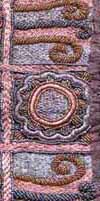40. FOUND AT LAST!
At last, after no end
of wandering in Gujarat, Gangabehn found the spinning wheel in Vijapur
in the Baroda State. Quite a number of people there had spinning wheels
in their homes, but had long since consigned them to the lofts as useless
lumber. They expressed to Gangabehn their readiness to resume spinning,
if someone promised to provide them with a regular supply of slivers, and
to buy the yarn spun by them. Gangabehn communicated the joyful news to
me. The providing of slivers was found to be a difficult task. On my mentioning
the thing to the late Umar Sobani, he solved the difficulty by immediately
undertaking to send a sufficient supply of slivers from his mill. I sent
to Gangabehn the slivers received from Umar Sobani, and soon yarn began
to pour in at such a rate that it became quite a problem how to cope with
it.
Mr. Umar Sobani's generosity
was great, but still one could not go on taking advantage of it for ever.
I felt ill at ease, continuously receiving slivers from him. Moreover,
it seemed to me to be fundamentally wrong to use mill-slivers. If one could
use mill-slivers, why not use mill-yarn as well? Surely no mills supplied
slivers to the ancients? How did they make their slivers then? With these
thoughts in my mind I suggested to Gangabehn to find carders who could
supply slivers. She confidently undertook the task. She engaged a carder
who was prepared to card cotton. He demanded thirty-five rupees, if not
much more, per month. I considered no price too high at the time. She trained
a few youngsters to make slivers out of the carded cotton. I begged for
cotton in Bombay. Sjt. Yashvantprasad Desai at once responded. Gangabehn's
enterprise thus prospered beyond expectation. She found out weavers to
weave the yarn that was spun in Vijapur and soon Vijapur Khadi gained a
name for itself.
While these developments were
taking place in Vijapur, the spinning wheel gained a rapid footing in the
Ashram. Maganlal Gandhi, by bringing to bear all his splendid mechanical
talent on the wheel, made many improvements in it, and wheels and their
accessories began to be manufactured at the Ashram. The first piece of
Khadi manufactured in the Ashram cost 17 annas per yard. I did not hesitate
to commend this very coarse Khadi at that rate to friends, who willingly
paid the price.
I was laid up in bed at Bombay.
But I was fit enough to make searches for the wheel there. At last I chanced
upon two spinners. They charged one rupee for a seer of yarn, i.e.,
28 tolas or nearly three quarters of a pound. I was then ignorant
of the economics of Khadi. I considered no price too high for securing
handspun yarn. On comparing the rates paid by me with those paid in Vijapur,
I found that I was being cheated. The spinners refused to agree to any
reduction in their rates. So I had to dispense with their services. But
they served their purpose. They taught spinning to Shrimatis Avantikabai,
Ramibai Kamdar, the widowed mother of Sjt. Shankarlal Banker, and Shrimati
Vasumatibehn. The wheel began merrily to hum in my room, and I may say
without exaggeration that its hum had no small share in restoring me to
health. I am prepared to admit that its effect was more psychological than
physical. But then it only shows how powerfully the physical in man reacts
to the psychological. I too set my hand to the wheel, but did not do much
with it at the time.
In Bombay, again, the same old
problem of obtaining a supply of hand-made slivers presented itself. A
carder twanging his bow used to pass daily to Sjt. Revashankar's residence.
I sent for him and learnt that he carded cotton for stuffing mattresses.
He agreed to card cotton for slivers, but demanded a stiff price for it,
which, however, I paid. The yarn thus prepared I disposed of to some Vaishnava
friends for making from it the garlands for the pavitra ekadashi.
Sjt. Shivji started a spinning class in Bombay. All these experiments involved
considerable expenditure. But it was willingly defrayed by patriotic friends,
lovers of the motherland, who had faith in Khadi. The money thus spent,
in my humble opinion, was not wasted. It brought us a rich store of experience,
and revealed to us the possibilities of the spinning wheel.
I now grew impatient for the
exclusive adoption of Khadi for my dress. My dhoti was still of
Indian mill cloth. The coarse Khadi manufactured in the Ashram and at Vijapur
was only 30 inches in width. I gave notice to Gangabehn that, unless she
provided me with a Khadi dhoti of 45 inches width within a month,
I would do with a coarse, short Khadi dhoti. The ultimatum came
upon her as a shock. But she proved equal to the demand made upon her.
Well within the month she sent me a pair of Khadi dhotis of 45 inches
width, and thus relieved me from what would then have been a difficult
situation for me.
At about the same time Sjt.
Lakshmidas brought Sjt. Ramji, the weaver, with his wife Gangabehn from
Lathi to the Ashram, and got Khadi dhotis woven at the Ashram. The
part played by this couple in the spread of Khadi was by no means insignificant.
They initiated a host of persons in Gujarat and also outside into the art
of weaving handspun yarn. To see Gangabehn at her loom is a stirring sight.
When this unlettered but self-possessed sister plies at her loom, she becomes
so lost in it that it is difficult to distract her attention, and much
more difficult to draw her eyes off her beloved loom.

